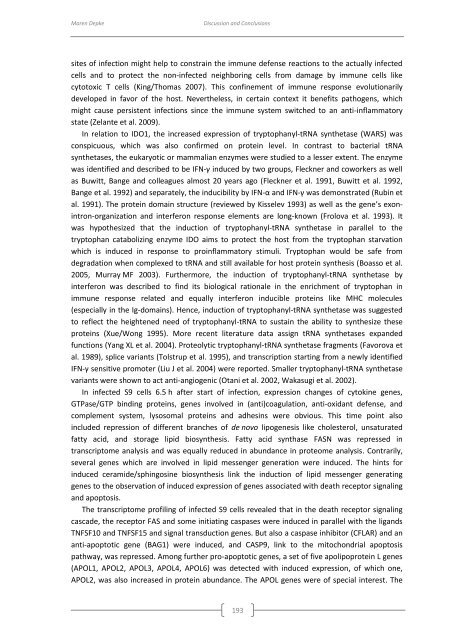genomewide characterization of host-pathogen interactions by ...
genomewide characterization of host-pathogen interactions by ...
genomewide characterization of host-pathogen interactions by ...
Create successful ePaper yourself
Turn your PDF publications into a flip-book with our unique Google optimized e-Paper software.
Maren Depke<br />
Discussion and Conclusions<br />
sites <strong>of</strong> infection might help to constrain the immune defense reactions to the actually infected<br />
cells and to protect the non-infected neighboring cells from damage <strong>by</strong> immune cells like<br />
cytotoxic T cells (King/Thomas 2007). This confinement <strong>of</strong> immune response evolutionarily<br />
developed in favor <strong>of</strong> the <strong>host</strong>. Nevertheless, in certain context it benefits <strong>pathogen</strong>s, which<br />
might cause persistent infections since the immune system switched to an anti-inflammatory<br />
state (Zelante et al. 2009).<br />
In relation to IDO1, the increased expression <strong>of</strong> tryptophanyl-tRNA synthetase (WARS) was<br />
conspicuous, which was also confirmed on protein level. In contrast to bacterial tRNA<br />
synthetases, the eukaryotic or mammalian enzymes were studied to a lesser extent. The enzyme<br />
was identified and described to be IFN-γ induced <strong>by</strong> two groups, Fleckner and coworkers as well<br />
as Buwitt, Bange and colleagues almost 20 years ago (Fleckner et al. 1991, Buwitt et al. 1992,<br />
Bange et al. 1992) and separately, the inducibility <strong>by</strong> IFN-α and IFN-γ was demonstrated (Rubin et<br />
al. 1991). The protein domain structure (reviewed <strong>by</strong> Kisselev 1993) as well as the gene’s exonintron-organization<br />
and interferon response elements are long-known (Frolova et al. 1993). It<br />
was hypothesized that the induction <strong>of</strong> tryptophanyl-tRNA synthetase in parallel to the<br />
tryptophan catabolizing enzyme IDO aims to protect the <strong>host</strong> from the tryptophan starvation<br />
which is induced in response to proinflammatory stimuli. Tryptophan would be safe from<br />
degradation when complexed to tRNA and still available for <strong>host</strong> protein synthesis (Boasso et al.<br />
2005, Murray MF 2003). Furthermore, the induction <strong>of</strong> tryptophanyl-tRNA synthetase <strong>by</strong><br />
interferon was described to find its biological rationale in the enrichment <strong>of</strong> tryptophan in<br />
immune response related and equally interferon inducible proteins like MHC molecules<br />
(especially in the Ig-domains). Hence, induction <strong>of</strong> tryptophanyl-tRNA synthetase was suggested<br />
to reflect the heightened need <strong>of</strong> tryptophanyl-tRNA to sustain the ability to synthesize these<br />
proteins (Xue/Wong 1995). More recent literature data assign tRNA synthetases expanded<br />
functions (Yang XL et al. 2004). Proteolytic tryptophanyl-tRNA synthetase fragments (Favorova et<br />
al. 1989), splice variants (Tolstrup et al. 1995), and transcription starting from a newly identified<br />
IFN-γ sensitive promoter (Liu J et al. 2004) were reported. Smaller tryptophanyl-tRNA synthetase<br />
variants were shown to act anti-angiogenic (Otani et al. 2002, Wakasugi et al. 2002).<br />
In infected S9 cells 6.5 h after start <strong>of</strong> infection, expression changes <strong>of</strong> cytokine genes,<br />
GTPase/GTP binding proteins, genes involved in (anti)coagulation, anti-oxidant defense, and<br />
complement system, lysosomal proteins and adhesins were obvious. This time point also<br />
included repression <strong>of</strong> different branches <strong>of</strong> de novo lipogenesis like cholesterol, unsaturated<br />
fatty acid, and storage lipid biosynthesis. Fatty acid synthase FASN was repressed in<br />
transcriptome analysis and was equally reduced in abundance in proteome analysis. Contrarily,<br />
several genes which are involved in lipid messenger generation were induced. The hints for<br />
induced ceramide/sphingosine biosynthesis link the induction <strong>of</strong> lipid messenger generating<br />
genes to the observation <strong>of</strong> induced expression <strong>of</strong> genes associated with death receptor signaling<br />
and apoptosis.<br />
The transcriptome pr<strong>of</strong>iling <strong>of</strong> infected S9 cells revealed that in the death receptor signaling<br />
cascade, the receptor FAS and some initiating caspases were induced in parallel with the ligands<br />
TNFSF10 and TNFSF15 and signal transduction genes. But also a caspase inhibitor (CFLAR) and an<br />
anti-apoptotic gene (BAG1) were induced, and CASP9, link to the mitochondrial apoptosis<br />
pathway, was repressed. Among further pro-apoptotic genes, a set <strong>of</strong> five apolipoprotein L genes<br />
(APOL1, APOL2, APOL3, APOL4, APOL6) was detected with induced expression, <strong>of</strong> which one,<br />
APOL2, was also increased in protein abundance. The APOL genes were <strong>of</strong> special interest. The<br />
193

















